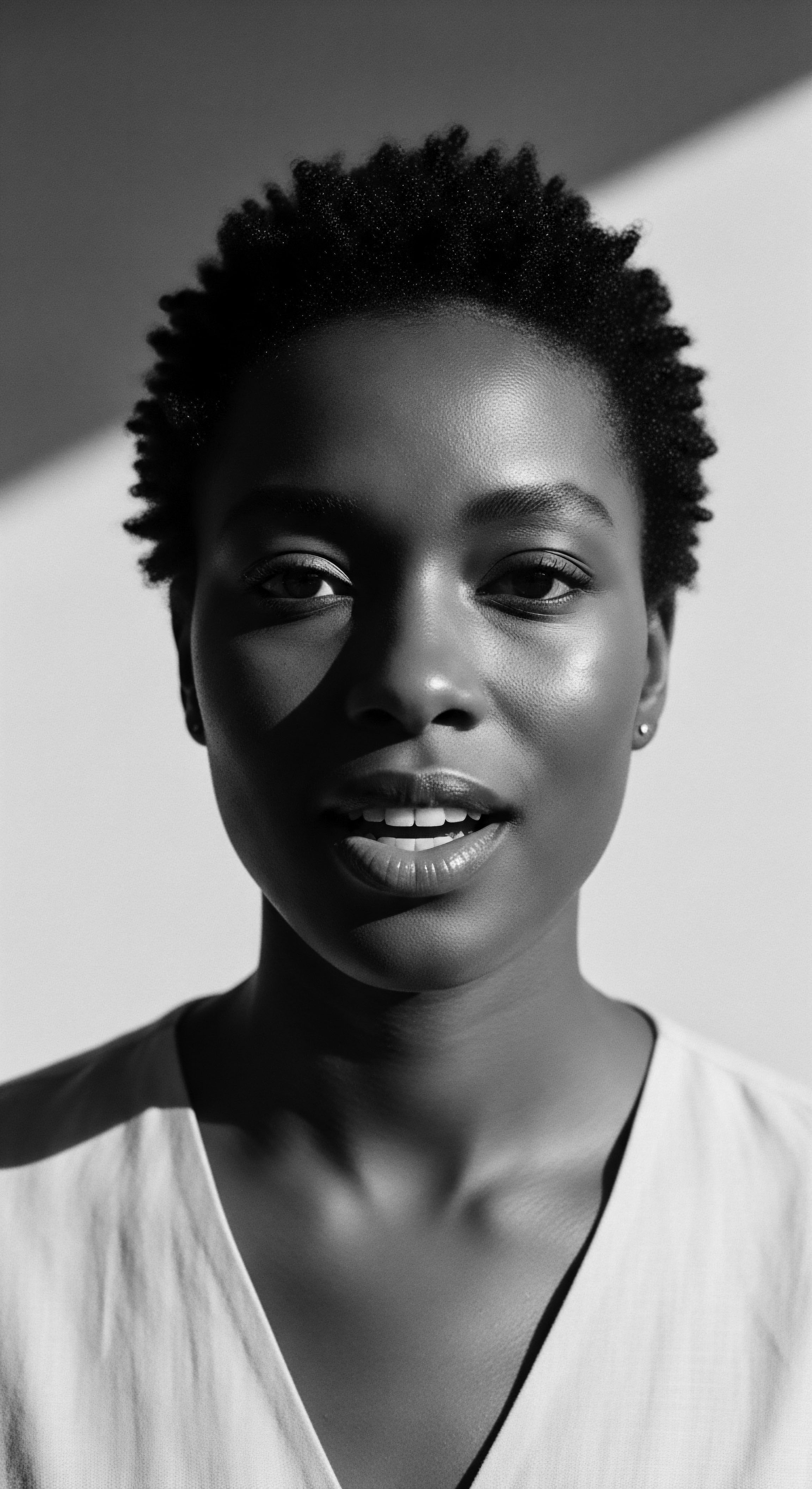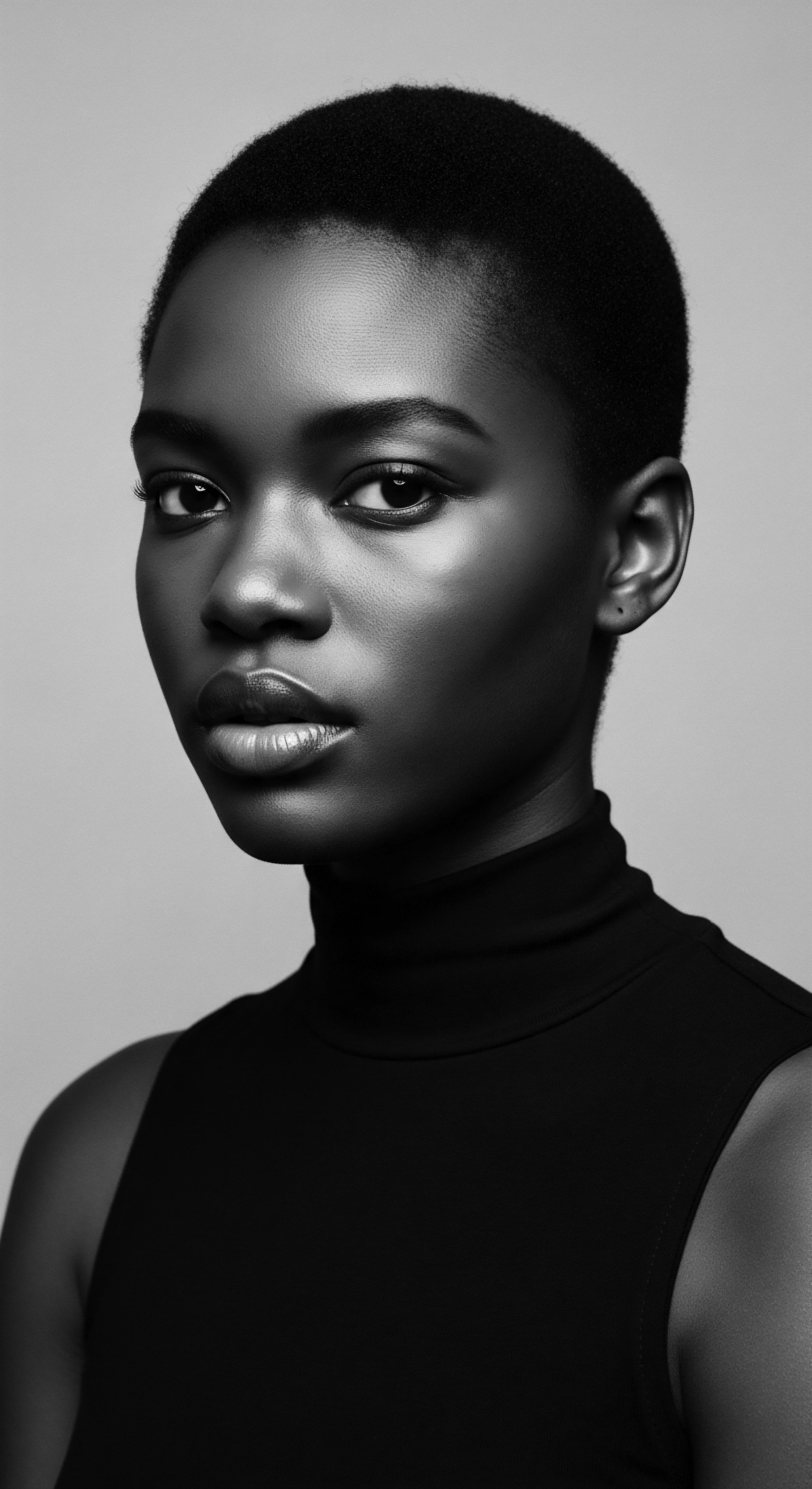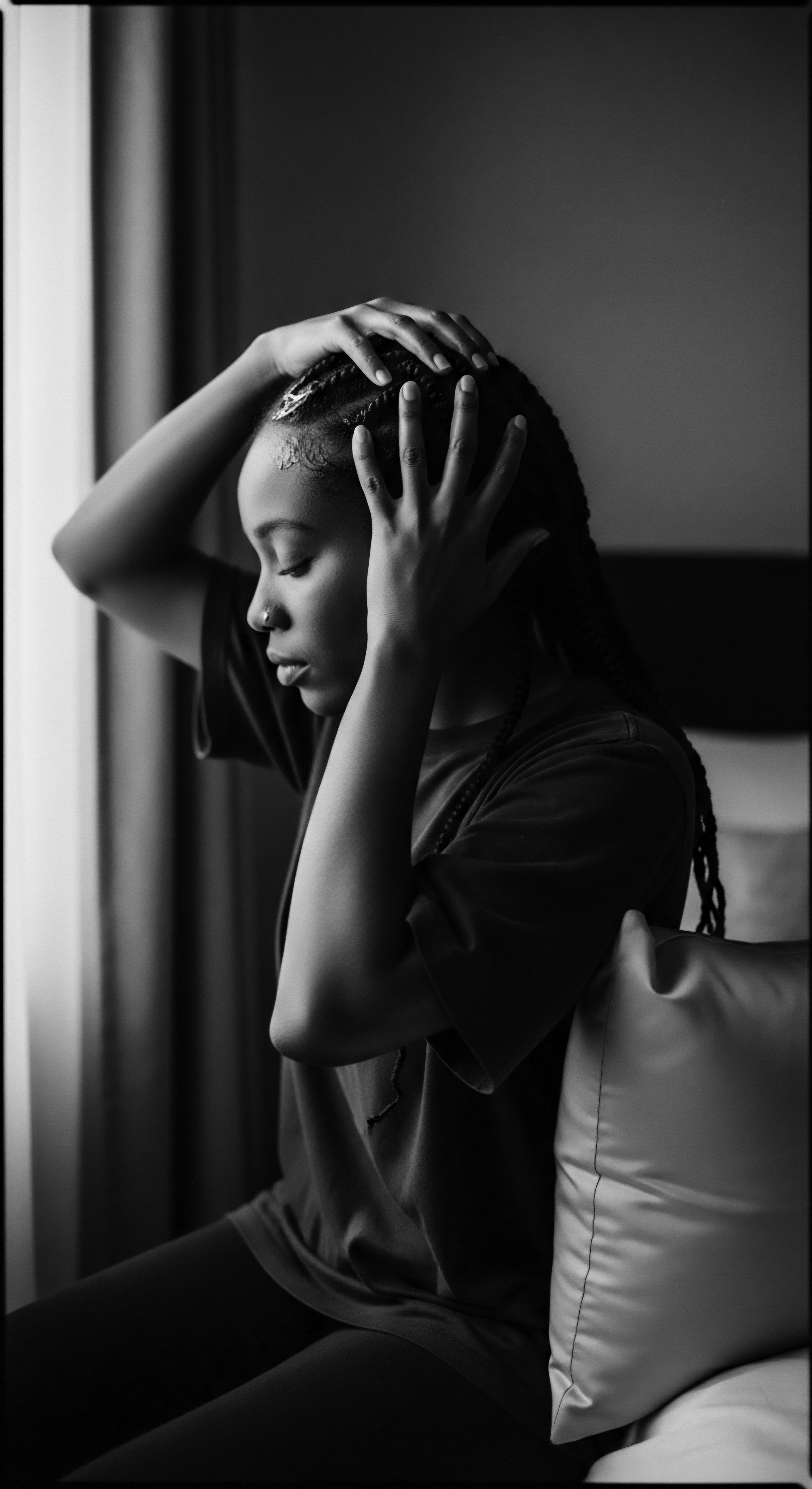
Roots
The very strands that crown a head of textured hair whisper stories, tales spun not merely of biology but of generations. They are a tangible scroll, inscribed with the deep cultural memory of ancestral lands, the resilience forged in transatlantic passages, and the vibrant life breathed into new worlds. For those whose lineage traces through the vast, complex expanse of Black heritage, hair care rises far beyond mere grooming; it stands as a fundamental expression of self, a sacred ritual, and a steadfast anchor to identity.
It embodies a living dialogue between past and present, a conversation where each coil, kink, and wave speaks volumes of survival, artistry, and an unbroken spirit. This exploration seeks to listen closely to those whispers, uncovering the profound ways in which our hair, in its magnificent, varied forms, has always been a beacon of who we are.

Anatomy and Ancestry
To truly comprehend the heritage of textured hair, one must begin with its elemental design. Consider the hair follicle, a tiny marvel of biological engineering, unique in its contribution to the distinctive coiling patterns seen in hair types across Black and mixed-race communities. Unlike straight or wavy hair, textured strands often emerge from an elliptical or flat follicle opening, causing the hair shaft itself to twist and spiral as it grows.
This helical structure, often a tight curl or a sharp zig-zag, fundamentally alters how light reflects, how moisture is retained, and how oils travel down the strand. Ancestral understanding of this distinct characteristic, long before modern microscopes, likely informed many traditional care practices focused on moisture preservation and gentle handling.
The very nomenclature we apply to hair, from the scientific classifications to the deeply personal descriptors, carries a weight of heritage. Modern systems often categorize hair based on its curl pattern, such as the widely recognized 3A to 4C scale. While these classifications aim for clarity, they occasionally touch upon historical biases, stemming from periods where hair textures closer to European standards were unfairly deemed more desirable.
Yet, within Black heritage, the descriptions of hair were often far richer, reflecting not just curl type but the specific way hair presented itself in communal settings, its spiritual meaning, or its role in daily life. This is a lexicon born of lived experience, celebrating the boundless diversity within textured hair itself.
Textured hair, from its very cellular architecture, holds within it the blueprint of a profound heritage, guiding the hands of those who tend to it with ancient wisdom.

Echoes From The Source
Before any colonial imposition, hair care practices in Africa were incredibly diverse, reflecting the continent’s myriad cultures, climates, and social structures. The preparation of traditional concoctions from indigenous plants — shea butter, aloe vera, various oils from local nuts and seeds — was not merely about cosmetic benefit. These rituals were steeped in spiritual belief, communal bonding, and medicinal application. Hair was adorned with cowrie shells, beads, and intricate thread work, each ornament carrying symbolic meaning ❉ status, age, marital state, tribal affiliation, or a connection to the divine.
The concept of hair as a conduit for spiritual energy, a point of connection to ancestors, was widespread. Head shaving, intricate braiding, and the deliberate shaping of hair into elaborate sculptural forms were all practiced, each with its own specific heritage and purpose. These practices were not static; they evolved, adapted, and were passed down, a continuous stream of knowledge. The materials used, the tools crafted, and the very hands that performed the care were all part of this enduring tradition, linking the physical act of hair care to the metaphysical realms of belief and identity.
- Shea Butter ❉ A cornerstone across West African communities, valued for its ability to soften, moisturize, and protect skin and hair from harsh environmental elements, a testament to ancestral botanical wisdom.
- Black Soap (Alata Samina) ❉ Originating from West Africa, made from the ash of local plants, cocoa pods, or plantain peels, offering a potent, clarifying wash for both body and hair, speaking to deep herbal knowledge.
- Henna ❉ Utilized in North Africa and parts of the Middle East, not only for dyeing hair but also for conditioning, strengthening, and its perceived protective spiritual properties, linking beauty to spiritual well-being.

Ritual
The tending of textured hair has always been a dance between tradition and adaptation, a testament to the ongoing resilience within Black heritage. The routines, the products, the very act of washing, detangling, or styling, all contain layers of meaning, often speaking to the enduring human need for connection and self-expression. In a world that often sought to diminish Black identity, the rituals of hair care became powerful acts of reclamation, a quiet, yet profound, statement of belonging and defiance.

The Tender Thread of Care
Consider the simple act of detangling, a necessary and often lengthy part of caring for coils and kinks. This is not a task to be rushed; it often necessitates patience, a gentle hand, and specific tools, like wide-tooth combs or fingers. In many homes across the diaspora, this process often occurred in communal settings. Mothers tended to daughters’ hair, sisters braided one another’s, and neighbors shared tips, a web of shared knowledge and affection.
These moments were, and remain, intimate gatherings where stories were exchanged, wisdom imparted, and bonds solidified. The communal aspects of hair care, far from being superficial, represent a living legacy of collective support and the intergenerational transfer of practical knowledge, all reinforcing a shared identity and heritage.
Protective styles, a cornerstone of textured hair care, also carry a rich lineage. From cornrows to braids, twists to locs, these styles serve to safeguard delicate strands from environmental damage, reducing manipulation and promoting length retention. Yet, their purpose has always been far greater than mere protection. Historically, these styles often indicated tribal affiliation, social standing, or age.
During periods of enslavement, the artistry of protective styling became a clandestine tool of resistance and survival. It is well-documented that enslaved African people ingeniously braided rice seeds into their hair before forced migration, ensuring that the legacy of their agricultural heritage could literally take root in new, foreign lands. Similarly, intricate cornrow patterns were sometimes used to create maps, guiding individuals towards freedom, a remarkable instance of hair as a living, breathing cartographic aid (Roberts, 2003, p. 7). This powerful historical example underscores how hair care, in its most profound forms, became intertwined with survival, collective knowledge, and an unwavering commitment to ancestral lineage.

Styling as Sustained Voice
The array of styles possible with textured hair stands as a vibrant palette for personal and collective expression. Natural styling, allowing the hair to display its inherent pattern without alteration, has experienced a resurgence, reclaiming the beauty of unadulterated coils and kinks. This movement is not simply a trend; it is a profound affirmation of self, a rejection of Eurocentric beauty standards, and a deep connection to ancestral ways of being. Learning to love and care for one’s natural texture, often a journey of self-discovery, mirrors the journey of reclaiming identity that has characterized much of Black history.
The mastery of techniques extends to the artistry of wigs and hair extensions, which also possess a historical presence within Black heritage, albeit one that has evolved dramatically. While sometimes associated with assimilation or protective measures in modern contexts, their use in ancient African societies often signified status, ritual, or adornment, reflecting the wearer’s position or an upcoming ceremony. The tools of hair care too, whether ancient combs carved from wood or contemporary detangling brushes, connect across generations, each an extension of the hands that tend to hair with diligence and love.
| Aspect of Care Detangling Tool |
| Ancient/Traditional Heritage Context Wide-tooth wooden combs, often hand-carved, used for gentle sectioning and untangling, respecting the hair's delicate structure. |
| Modern Heritage Adaptation/Scientific Link Detangling brushes with flexible bristles or ergonomic designs, scientifically engineered to reduce breakage and friction, yet upholding the principle of gentle care. |
| Aspect of Care Moisturizer Source |
| Ancient/Traditional Heritage Context Shea butter, coconut oil, palm kernel oil, sourced directly from plants, used for deep conditioning and sealing moisture, reflecting localized botanical knowledge. |
| Modern Heritage Adaptation/Scientific Link Commercially produced leave-in conditioners and hair milks, often formulated with traditional oils and humectants, delivering moisture with scientific precision. |
| Aspect of Care Protective Styling |
| Ancient/Traditional Heritage Context Cornrows for mapping escape routes or hiding seeds; braids for tribal identification; locs as a spiritual symbol. |
| Modern Heritage Adaptation/Scientific Link Box braids and faux locs for aesthetic and protective purposes, often worn to honor cultural heritage while providing versatile styling options. |
| Aspect of Care Cleansing Method |
| Ancient/Traditional Heritage Context Herbal rinses and plant-derived soaps (like black soap) for gentle, purifying washes, relying on natural saponins. |
| Modern Heritage Adaptation/Scientific Link Low-lather shampoos or co-washes, formulated to cleanse without stripping natural oils, recognizing the unique moisture needs validated by scientific understanding. |
| Aspect of Care The continuity of care, even with new tools, speaks to a deeply ingrained respect for textured hair's unique needs, a constant dialogue between heritage and ingenuity. |

Relay
The heritage of textured hair care does not simply reside in historical artifacts or dusty archives; it is a living, breathing relay race, passed from hand to hand, generation to generation. Each brush stroke, each twist of a loc, each thoughtful choice of ingredient, carries with it the accumulated wisdom of those who came before. This is where the nuanced intersection of ancestral practice, personal well-being, and scientific validation truly comes into its own, solidifying the enduring link between hair and identity within Black heritage.

The Nighttime Sanctuary ❉ A Heritage of Protection?
Perhaps no ritual more potently signifies continuous care for textured hair than the nighttime routine. The seemingly simple act of wrapping one’s hair in a silk or satin scarf, or donning a bonnet, is not a modern invention. This practice has roots in ancestral wisdom, long before synthetic fabrics.
The understanding that fragile coils and kinks needed protection from friction, moisture loss, and tangling during sleep was inherent. The purpose was not just about maintaining a style; it was about preserving the hair’s health, its integrity, which was directly tied to a person’s presentation and self-respect.
This practice is a microcosm of the larger heritage of care. It speaks to a deep, practical knowledge of textured hair’s delicate nature ❉ its proneness to dryness, its susceptibility to breakage from abrasive materials. The satin bonnet, a symbol of personal hair care for many Black women globally, represents a culmination of this wisdom, a direct descendant of the head wraps and coverings worn by ancestors for both protection and adornment. Its prominence today serves as a quiet but powerful statement of cultural continuity, a daily acknowledgment of a shared ancestral practice.

Holistic Influences on Hair Health ❉ What Does Ancestral Wisdom Inform?
The idea of hair health as an isolated concern is a modern construct. Traditional African wellness philosophies, from which much Black heritage stems, consistently viewed the body as an interconnected system. The vitality of hair was often seen as a reflection of overall health, spirit, and connection to one’s environment. This holistic perspective meant that diet, spiritual balance, community well-being, and even connection to the earth were all considered integral to maintaining healthy hair.
This is where the scientist’s lens often validates ancestral observation. Modern nutritional science confirms that protein, vitamins (especially biotin and vitamin D), and minerals (like iron and zinc) play crucial roles in hair growth and strength. Ancestral diets, often rich in diverse plant-based foods, lean proteins, and healthy fats, intuitively provided many of these essential nutrients.
Similarly, stress, a modern epidemic, is now scientifically linked to hair loss and thinning, something likely understood through anecdotal evidence in communities where harmony and collective care were prioritized. The enduring heritage of holistic self-care, where hair is a barometer of inner well-being, provides a comprehensive approach that transcends mere superficiality.
Hair care rituals are not just about aesthetics; they are a profound expression of self, a celebration of resilience, and a quiet act of cultural affirmation.

Problem Solving and Persistent Spirit
Challenges with textured hair – dryness, breakage, shedding – are not new phenomena. Generations have grappled with these concerns, often developing ingenious solutions rooted in their environment and communal wisdom. The ingenuity often involved leveraging local botanicals, specific techniques, and shared knowledge. For instance, the practice of creating “hair teas” from boiled herbs or applying various plant-based oils was a common approach to address scalp conditions or dryness.
The persistent spirit in addressing hair concerns speaks to the profound value placed on hair as a marker of identity and heritage. Even amidst periods of discrimination and forced assimilation, the care and adornment of textured hair continued, sometimes subtly, sometimes defiantly. This unyielding dedication to hair health and expression became a form of resistance, a refusal to let external pressures dictate personal identity. The continuous refinement of techniques, the sharing of remedies, and the enduring celebration of diverse textures illustrate a legacy of deep affection and commitment to this unique aspect of Black identity.
- Moisture Retention Techniques ❉ Historically, the use of heavy oils and butters was common to seal moisture into porous textured strands, a practice refined today with lighter oils and humectants to prevent product build-up.
- Scalp Care Practices ❉ Traditional remedies involved rubbing specific leaves or bark decoctions onto the scalp to address flakiness or irritation, now understood through the lens of their anti-inflammatory or antimicrobial properties.
- Gentle Manipulation ❉ The inherent understanding that textured hair requires gentle handling to prevent breakage, manifested in practices like finger-combing or slow, deliberate braiding, remains a fundamental tenet of care.

Reflection
As we close this dialogue on the enduring journey of textured hair within Black heritage, it becomes abundantly clear that our coils and kinks are more than simple fibers. They are living archives, repository of ancestral wisdom, resilience, and unyielding beauty. The very act of caring for these strands—from the deliberate detangling to the celebratory styling, from the protective nighttime rituals to the mindful choice of natural ingredients—is a continuous act of affirmation, a dialogue with our past, and a powerful statement of our present.
This deep affection for textured hair, so uniquely its own, is a testament to a heritage that has navigated immense challenges, yet always found a way to celebrate its intrinsic worth. Roothea’s ‘Soul of a Strand’ ethos is precisely this ❉ an invitation to honor the profound legacy etched into each helix, acknowledging that in tending to our hair, we tend to a living piece of our history, a luminous thread connecting us to the boundless spirit of our ancestors, and a vibrant promise for the generations yet to come.

References
- Roberts, Michele. (2003). Hair Story ❉ Untangling the Roots of Black Hair in America. St. Martin’s Press.
- Tharps, Lori L. and Byrd, Ayana D. (2014). Hair Story ❉ Untangling the Roots of Black Hair in America. St. Martin’s Griffin.
- Akbar, Na’im. (1998). Light from Ancient Africa. New Mind Productions.
- White, Deborah G. (1999). Ar’n’t I a Woman? Female Slaves in the Plantation South. W. W. Norton & Company.
- Gale, R. (2001). African Hairstyles ❉ Styles of Yesterday and Today. Africa World Press.
- Banks, Ingrid. (2000). Hair Matters ❉ Beauty, Power, and the Politics of Dreadlocks. New York University Press.
- Mercer, Kobena. (1994). Welcome to the Jungle ❉ New Positions in Black Cultural Studies. Routledge.
- Jackson, Jacquelyn. (1976). Black Women in America ❉ The Quest for Identity. Thomas Y. Crowell Company.
